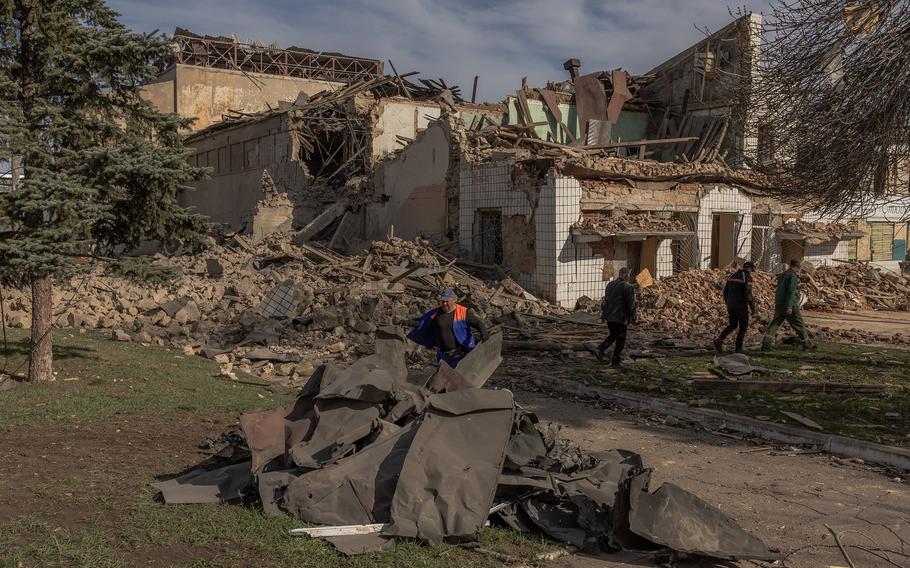
Communal workers clear rubble following an overnight missile strike on a House of Culture in the town of Druzhkivka, Donetsk region, on Monday, April 1, 2024, amid the Russian invasion of Ukraine. (Roman Pilipey, AFP/Getty Images/TNS)
(Tribune News Service) — President Vladimir Putin is determined to grind Ukraine into submission, betting he can outlast Kyiv’s Western backers and claim victory on the battlefield even as Russian troops make only halting progress.
Bolstered by a new six-year term in power and attempting to blame Kyiv for Russia’s worst terror attack in two decades, Putin’s committed to pursue his war goals after a tentative diplomatic outreach to the U.S. late last year came to nothing, said four people familiar with the Kremlin’s military strategy.
U.S. officials have said they saw no indication the Russian president was serious late last year about looking for a way to end the fighting, and have rejected the idea of cease-fire talks without Ukraine.
“Putin’s likely to escalate now,” said Alexei Mukhin, head of the Moscow-based Center for Political Information, which provides consultancy services for the presidential administration. “His goal is victory.”
With Russia far short of the manpower needed for a decisive breakthrough, and Ukraine struggling to supply its forces with munitions, there’s no sign either side can compel an end to the fighting any time soon. Since winning last month’s election, Putin has stepped up missile barrages at Ukrainian cities, saying he’s not interested in giving Ukraine and its allies time to re-arm if he agrees to a pause in the fighting.
Putin has accused Ukraine without evidence of playing a role in the March 22 concert hall attack in Moscow that killed at least 144 people, even though Islamic State claimed responsibility and U.S. officials say the group is solely responsible. That’s stoked speculation the Kremlin may be preparing the ground for measures to intensify the war, including potentially another mobilization of reservists even as Russia’s wartime economy is already struggling with labor shortages.
Russia plans to form two new combined armies, 14 divisions and 16 brigades by the end of this year, according to Defense Minister Sergei Shoigu. So far, the military has been expanding its ranks by attracting recruits with the promise of generous pay and aims to enlist at least 250,000 more soldiers in 2024.
“Groups of Russian forces continue to push Ukrainian formations westward,” Shoigu said at a teleconference with senior officers on Tuesday.
Still, Russia may struggle for now to mount major new offensives to capture cities such as Kharkiv in the northeast, the region it was forced to withdraw from in late 2022, and the southern port city of Odesa. A plan Putin announced to carve out a buffer zone in Ukraine to shield Russian border regions from intensifying attacks also looks unrealizable without more troops.
“I don’t believe the takeover of Kharkiv is possible. The Kremlin doesn’t have enough forces for such a task and the city is too big,” said Ruslan Pukhov, head of the Centre for Analysis of Strategies and Technologies, a defense think tank in Moscow. “For a real breakthrough in this war, Russia needs much better communication capabilities, many more high-precision weapons and many more people.”
Ukraine faces its own mounting challenges. President Volodymyr Zelenskyy signed a bill Tuesday to lower the age of wartime conscription to 25 from 27 as his military seeks to replenish its depleted ranks.
Having failed to achieve a breakthrough in last year’s counteroffensive, Ukrainian forces are now wrestling with increasingly severe ammunition shortages as Republicans in the U.S. Congress hold up a $60 billion military aid package.
Russia’s seizing the opportunity to mount attacks across the front line after it took the strategic eastern town of Avdiivka in February. So far, it’s making only local advances, though Zelenskyy warned in a Washington Post interview last week that delays in U.S. assistance mean “we will go back, retreat, step by step.”
French President Emmanuel Macron has attempted to raise the stakes by talking about sending troops to Ukraine to prevent a Russian victory, though he’s met with a cautious response from the U.S. and other key European allies.
U.S. Defense Secretary Lloyd Austin warned last month that “Ukraine’s survival is on the line” as he pledged to keep military assistance flowing. U.S. House Speaker Mike Johnson said in a Fox News interview Sunday that legislators would take up the aid package “right away,” though he’s still grappling to soften opposition from hardliners.
“If this long-term question is not resolved, on the pathway the war is on now, things start to look very bad for Ukraine by the autumn,” Dara Massicot, senior fellow at the Carnegie Endowment for International Peace and a former analyst of Russian military capabilities at the U.S. Defense Department, said by phone.
The prospect of Donald Trump returning to the White House in November’s presidential election is also raising concern in Ukraine and Europe that U.S. military support may wither.
Kremlin spokesman Dmitry Peskov last month said Russia is de facto at “war” in Ukraine because of the West’s deepening involvement, though Putin hasn’t formally declared hostilities since ordering the February 2022 invasion. Russia currently controls about a fifth of Ukraine, including Crimea, which it annexed in 2014.
While Russia has ramped up arms production, it’s also re-using a lot of Soviet-era equipment and slowly eating through reserves of weaponry, which will become scarcer in 2025-2026, according to Carnegie’s Massicot.
Still, “Russia is ready to pursue this conflict for as long as it takes,” said Mukhin, the Kremlin consultant.
©2024 Bloomberg News.
Visit bloomberg.com.
Distributed by Tribune Content Agency, LLC.